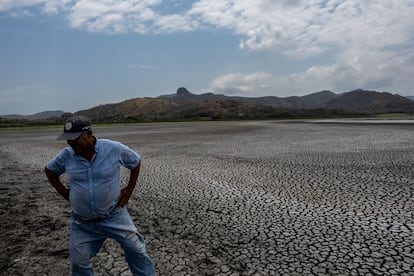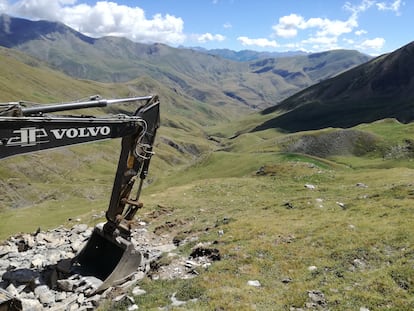The drought that is scorching Mexico, a predictable and devastating tragedy
A lack of rain, the transformation of the earth and bad water management have condemned the country to repeat the agony of extremely dry seasons every decade, with their resulting social and economic consequences
The drought that is scorching Mexico,
a predictable and devastating tragedy
The drought currently ravaging Mexico is a recurring phenomenon that leaves a trail of damage and destruction in its wake every time it strikes. At the moment 84% of the country is suffering drought conditions of differing intensity, aggravated by a lack of rain in recent months, according to Monitor, the surveying service of the National Water Commission (Conagua). Despite the fact it had been predicted, and that the evolution of the climatic history of Mexico tends toward drought conditions, the current dry spell caught Ermenegildo Martínez by surprise. “It was 13 meters deep and now there’s hardly 10 centimeters left. In less than a week it will all have gone,” says the fisherman of the lake where he plies his trade in Veracruz.
Over 800 miles away, in Sinaloa, the farmer Gumaro López shares Martínez’s pessimism. Like the fisherman, López anticipates crop losses and warns that prices will spike. It has happened before, in 1996 and 2011, the last two occasions when severe droughts descended on Mexico and from which, it is abundantly clear, not enough lessons were learned.
Mexico’s geographical location and its climate make the country extremely vulnerable to droughts and periods of high rainfall. Surviving the dry season depends in large part on how much water has been accumulated during the wet months. In 2020, the rains were not sufficient to fill all of the country’s network of dams and now, as a consequence, of the 210 biggest in Mexico, more than half are at less than 50% of their capacity. Furthermore, 61 are at critical levels at less than 25% capacity, mostly in northern and central Mexico.
Despite the area most affected by droughts – 60% of Mexico’s land mass - being historically accustomed to extreme conditions, in Veracruz this year the dry season has caused some extremely worrying scenes. Ermenegildo Martínez has been a fisherman for 20 years and usually casts his rod at Farallón, a fresh water reserve that sustains 200 families who make their living fishing. Eight months ago, Martínez began to notice that the drop in water level was getting more and more pronounced until there was barely enough remaining to cover the knees of the fishermen. “This drought is more severe, and on top of that, water from the lake is also siphoned off by farmers and for irrigation at the ranches in the area,” says Martínez, who until the drought hit would usually land five kilos of fresh water bream, worth 250 pesos, per day.
Martínez has seen the water level in the lake drop before, especially during the dry seasons that occur between September and May. The last major drought, in 2011, caused a famine and a humanitarian crisis in Chihuahua State. At that time more than 95% of the country was affected and almost a quarter of Mexico was under the highest alert level for severe drought. The most recent data places the current dry spell dangerously close to a similar catastrophe, with 83.9% of Mexico under drought conditions.
Benjamín Martínez López, a researcher at the UNAM Center for Atmospheric Sciences, explains that how much it rains or fails to do so, and the duration of droughts, depends on a complex atmospheric system and the link between the El Niño and La Niña climatic phenomena. When the surface water of the eastern Pacific Ocean - which surrounds Mexico’s coasts - cools there is a lack of rain on the continent, which is what is happening now. This phenomenon is known as La Niña. When the warmer waters of the seas in Indonesia move toward the other side of the Pacific, the surface temperature on the coasts of Central America will warm and the resulting evaporation will form rain clouds and provoke hurricanes. “At the moment La Niña is diminishing and in the next few weeks the surface water will warm up and the rains will come,” Martínez López says.
Views of the island in the center of Lake Cuitzeo in Michoacán
This cyclical weather pattern dictates when wet seasons will arrive and how long they will last. Martínez López adds that within these variations there are trends of drier and wetter periods that can last for up to 15 years and that, despite the drought currently gripping Mexico, average rainfall at the moment is higher in comparison to 20 years ago. In 1996, the worst drought ever recorded caused untold losses in crop production, to the point that exports were halted and ranchers were forced to sell their livestock off at cut-price rates to prevent the animals from starving to death. Since then, average annual rainfall has been increasing. “Climate change is leading to more Niñas, which in turn produces more hurricanes and more rain in the region,” says Martínez López. As such, the amount of rain that falls on Mexico should be sufficient to ride out droughts: the problem lies in other factors.
José Antonio Benjamín Ordoñez-Díaz, a professor at the Monterrey Institute of Technology, points out that droughts have always existed but human activity has made their consequences more damaging and led to a shortfall in the availability of water. Deforestation, the sprawl of urban development and the destruction of forests and wetlands for agricultural land have all affected the capacity for water retention. “When you cut down a tree, you are removing half its weight in water from that ecosystem,” he says to explain that without vegetation, water cannot filter into the ground and evaporates more quickly. The rise in average temperature – from 20.4 degrees Celsius in 1985 to 22.4 degrees in 2019 – has exacerbated the problem. As temperatures rise, the ground dries out more rapidly and forest fires become more frequent, destroying more vegetation and biodiversity.

Water use in Mexico is also a cause for concern over the long-term sustainability of this vital resource: 76.6% is used for agricultural irrigation, 14% for domestic use and the remainder for industry and electricity generation. Judith Domínguez, a researcher at the College of Mexico and coordinator of the Water Security Observatory, says that public management of water is another important factor. “We are better prepared in terms of information, but at the end of the day everything is subject to political, unplanned decisions when preventive decisions based on technical criteria are needed,” Domínguez says. “If we know that we will have cyclical droughts, we need to change our crops. For example, in the very dry states in the north we grow alfalfa, which requires huge amounts of water.” Domínguez adds that if a drought is forecast with months of notice, efforts could be made to reduce the strain on supply through domestic and agricultural consumption. “In the end, it simply confirms what international studies on the water crisis have concluded: it is a crisis of management and governance.”
The lake in Farallón, with its cracked brown soil like that of many others across the country, is a prime example of this. In the 1940s water was scarce, as it is now, but the lake was fed by streams flowing down nearby hills. In 1955 Hurricane Hilda filled Farallón to bursting point and that was sufficient to maintain healthy water levels for many years. However, overexploitation of sugar cane crops replaced seasonal agriculture, the density of vegetation in the hills was reduced by logging and the spread of urban development encroached more and more. As a result, the lake’s sources of replenishment were eaten away and now it is a mere ripple 10cm deep. Ermenegildo Martínez says this water will evaporate, irreversibly, within a week. “What are we going to do when we have nowhere left to fish?” he asks.
In the north of the country, the same tragedy is playing out. Gumaro López Cuadras has grown corn and beans for 40 years in the Évora valley, in central Sinaloa State. When he was alerted that water levels in the dams had fallen dramatically, to as low as 18.23% of capacity as of April 15, he installed an irrigation system to reduce the flow of water to his land by half to at least try an save his legume crop, produce that grows well even in the absence of water. “I hope it rains, because we are struggling,” he says. “Crops that require little water are not profitable for farmers: we only plant them to make use of the spare plots.”
Ranchers are also direct victims of the drought. Joaquín Arizpe, president of the Regional Livestock Union of Coahuila, says there have been reports of animals dying of starvation, as happened in 1996 and 2011. When there is no rain, ranchers cannot plant foliage for their cattle to feed on, and they are forced to replace greenery in the animals’ diets with a protein supplement. The cattle are also obliged to walk much further to find water and sometimes it is necessary to drive them in trucks to the nearest source. With the dams empty costs increase, and in the worst of cases the herds simply die of starvation.
A lack of scientific investigation to develop technologies and preventive plans to avoid a lack of water in the dams is one of the main reasons history will continue to repeat itself in Mexico, says Martínez López. “It is essential to understand how our water system works to simulate eventualities and prepare ourselves for droughts,” he says. In the view of this UNAM scientist, the amount of rain that Mexico receives ought to be sufficient if it stored well and losses through deteriorating infrastructure are avoided. Gray water and black water should also be differentiated between, so that the former can be purified and recycled for agricultural uses. “Science is an investment, but it pays off and gives back to society in the end.”
English version by Rob Train.

